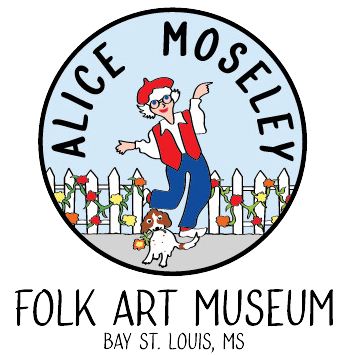click image to fit to your screen
Heavens Greatest Gift
1991 Year, Alice Moseley
18” x 24”, acrylic on wood
On display at the Alice Moseley Museum
Donated by Dennis and Julie Smith
Heavens Greatest Gift
Heavens Greatest Gift, is a painting that provides an interesting way to look at the tension between the history of sharecropping in the American South and the idyllicism of Alice’s art. Sharecropping is defined as “a system where the landlord allows a tenant to use the land in exchange for a share of the crop.” In reality, sharecropping was an exhausting and exploitative practice that often kept families deeply in debt. Sharecroppers could not afford their own equipment; the equipment was leased, and the seed and fertilizer given on credit. Interest rates were often disproportionately high, and if something went wrong with the crop, the debt owed would only grow.
Sharecroppers, both white and black, had difficult lives, dealing with unfair landowners and unscrupulous business practices. Black sharecroppers also had to deal with hateful Jim Crow laws and extreme racist violence. The vast majority of landowners were white, and many were former slave owners. In the majority of cases, sharecropping was another form of forced labor from which there was no legal recourse to escape.
Heavens Greatest Gift is a painting that shows black sharecroppers going about their daily lives. The title, painted on cotton, seems to suggest that cotton is “heaven’s greatest gift,” allowing the sharecroppers to make their living. Intent is hard to decipher, especially when Alice herself has passed, but if taken at face value, the idea of cotton as a gift from heaven is certainly problematic at best. Cotton made the South rich at the expense of African Americans who were forced into the barbarous and inhuman system of chattel slavery. Sharecropping was another form of slave labor that trapped people in a vicious cycle of poverty.
The beauty of art is that it means different things to different people. People bring their own experiences and values when evaluating art. While I do not think artistic intent should be dismissed completely, it is important for a piece of work to stand on its own. It is important for people to have their own emotional responses, all of which are valid. In my view, while several of her works romanticize the past, it also reminds the viewer that while people experienced hardship, they led full lives. These people experienced pain, cruelty, and hardship, but likewise love, joy, and the comfort that a supportive family can provide. For Alice, her joyous works were a way to honor those hard-working people who faced adversity. The humanity of people is on full display in Alice’s work. As a curator, my hope is that we remember both: the oppression and hardships that people faced, as well as their essential humanity and dignity.
References:

